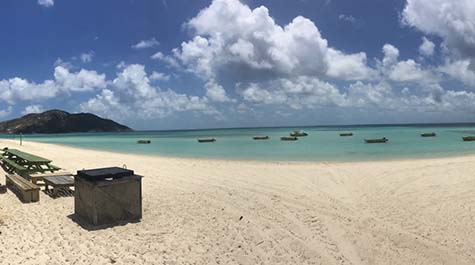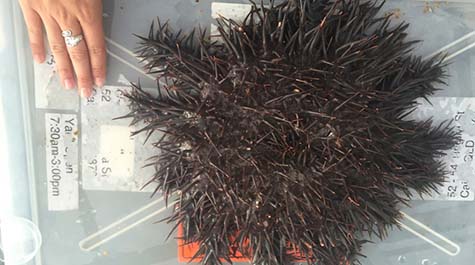Undergrad research goes global
It’s more than just snorkeling and counting worm poop
Research opportunities for undergrads are plentiful at William & Mary, but that doesn’t mean that all great research must happen in Williamsburg. In fact, sometimes students chase their curiosity to laboratories halfway across the world.
Kharis Schrage’s research interests took her to Australia where she led a team investigating how a species of sea star has been responsible for 40% of the destruction of the Great Barrier Reef.
The species in question—crown of thorns—can grow to be about the size of your average umbrella. Outbreaks have been reported with increasing frequency, potentially killing off coral faster than it can recover. Researchers have tried multiple strategies to control the populations, but their attempts have failed leaving them scratching their heads about what to do.
To investigate which environmental stressors could be responsible for the increased population booms, the student and her international colleagues looked at how larvae develop in different levels of salinity, pH, temperature and nutrients. In the lab, the team monitored the growth of embryos and hatching under these different conditions to see which were most stressful to their development. They discovered that lower salinity lowers fertilization rates and delays hatching, negative consequences for development that may be offset by nutrient runoff that drives population booms.
It’s that question and more that left Schrage and her team questioning how we can stop crown of thorns from wiping out our coral reefs. The short answer? “Stop dropping a bunch of nutrients in the ocean. ” It is within our control to limit the amount of food reaching these larvae, which will alter their reproductive cycle to one that allows the corals to recover.
Schrage said the experience was something she never thought she would have the opportunity to do as an undergraduate. Within 20 minutes of arriving in Australia, she was in the lab conducting her own research, coordinating the lab and working with her colleagues to better understand the biology of these organisms.
Though snorkeling every day does sound like a pretty sweet deal, she admits if you’re going to get involved in research your experience in the lab will vary based on the kind of work you’re doing. “Basically, I count worm poop,” she laughs.
Science isn’t always glamorous. While some weeks are spent in the field, others are spent running experiments and entering data in the lab. Conducting research is not about having a resume builder, it is about learning how to contribute to the scientific community in a meaningful way.
According to Schrage, the most important aspect of any research lab is finding a collaborative environment in which everyone has a shared excitement for the work being done. In this particular case, Schrage’s experience provided her with the tools necessary to make it in the field of science and experiences she may have otherwise never had. And for that, she wouldn't give up counting worm poop for anything.
This feature was adapted from a W&M Blogs post.

















